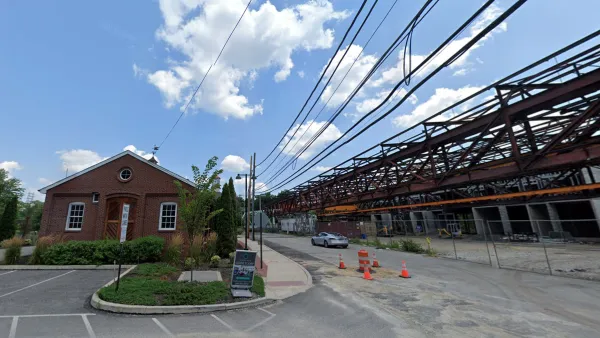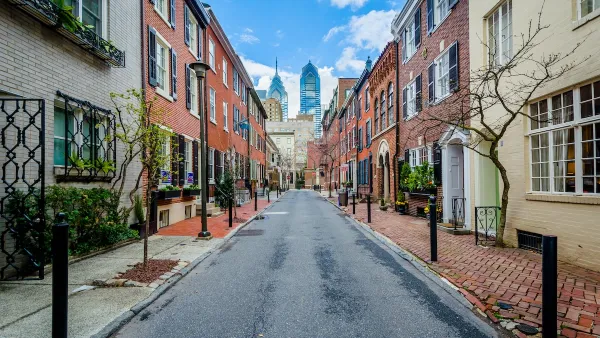Philadelphia's waterfront is about to get a new face. Race
Street Pier, set to open May 11th of this week, is more than just a
park. Tucked under the shadow of the Ben Franklin Bridge, the pier juts over
500 feet into the brown waters of the Delaware, providing park-goers with a
setting both intimate and dramatic in which to re-engage with the one of the
most storied riverfronts in the country.
While its aims are grand, the park's design is relatively simple.
The northern side of the 80 foot wide pier is elevated to serve as a tree-lined
promenade, giving city residents and tourists views up and down the river that
stretch for miles. Shrubs and other textured plantings create space on the
pier's lower, southern side for more passive recreation. "It's about
dramatizing the theater of being able to come out into the space of river,"
said James Corner of Field Operations -- the NYC-based firm responsible for the
park's design -- at the park's 2009 groundbreaking ceremony.
True to Corner's words, the site doesn't lack for drama. Situated
at the apex of the I-95 highway and the Ben Franklin Bridge, Race Street Pier
is a place where park-goers are as immersed in the roar of traffic as they are
in river views.
Which is why Philadelphia's newest public park is as much
educational tool as it is recreational experience. When people view the
Delaware from such a close vantage point, they get a feel for the force and
flow of the river, a system that has shaped the landscape of Philadelphia for
millennia. That the sight, sounds and smells of urban life surround Race Street
Pier sends the subliminal message that the two – riverside and city – are intrinsically
connected.
Creating such a place wasn't easy. When it opens on
Wednesday, Race Street Pier will be the first completed project of the Civic
Vision for the Central Delaware, one of the most civically engaged and
politically charged planning processes in recent history. When initial planning
began over five years ago, Philadelphia's seven-mile long riverfront area was
a fractured landscape. It was a time of easy money and development speculation,
and pressures to turn the postindustrial parcels lining the Delaware river into
more big-box development and highway design were everywhere. At the time, there
was no formal riverfront development commission to lead development and
Philadelphia's aged zoning code allowed political pressures to invade the
planning process. It took multiple outside consulting firms, intense media
coverage, philanthropic support, and the participation of more than four
thousand Philadelphians to turn things around.
The degree to which Race Street Pier re-connects
Philadelphia with the river of its birth is proof that things have changed.
Even the park's name – switched from the original Pier 11 to Race Street – is
used to reinforce the relationship between the riverfront pier and the rest of
the city grid. Even with such efforts, however, the site is hard to find. Cut
off from much of the city by the I-95, Race Street Pier retains the isolated
quality characteristic of Philadelphia's waterfront since the highway was built
in the 1960s.
The opening of the park is an important
step in bridging that divide. Says Jesse Barns of South Philadelphia, "I like
that it gets us out on the water." While other, already developed riverfront
areas provide ample recreational space, none jut into the drama of the Delaware
like Race Street Pier. In this park, being on the water is what it's all about.

National Parks Layoffs Will Cause Communities to Lose Billions
Thousands of essential park workers were laid off this week, just before the busy spring break season.

Retro-silient?: America’s First “Eco-burb,” The Woodlands Turns 50
A master-planned community north of Houston offers lessons on green infrastructure and resilient design, but falls short of its founder’s lofty affordability and walkability goals.

Delivering for America Plan Will Downgrade Mail Service in at Least 49.5 Percent of Zip Codes
Republican and Democrat lawmakers criticize the plan for its disproportionate negative impact on rural communities.

Test News Post 1
This is a summary

Test News Headline 46
Test for the image on the front page.

Balancing Bombs and Butterflies: How the National Guard Protects a Rare Species
The National Guard at Fort Indiantown Gap uses GIS technology and land management strategies to balance military training with conservation efforts, ensuring the survival of the rare eastern regal fritillary butterfly.
Urban Design for Planners 1: Software Tools
This six-course series explores essential urban design concepts using open source software and equips planners with the tools they need to participate fully in the urban design process.
Planning for Universal Design
Learn the tools for implementing Universal Design in planning regulations.
EMC Planning Group, Inc.
Planetizen
Planetizen
Mpact (formerly Rail~Volution)
Great Falls Development Authority, Inc.
HUDs Office of Policy Development and Research
NYU Wagner Graduate School of Public Service






























